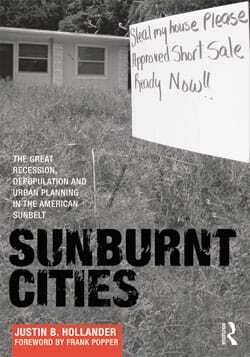Sunburnt Cities: The Great Recession, Depopulation, and Urban Planning in the American Sunbelt
Justin B. Hollander
Routledge
270 Madison Avenue, New York, NY 10016;
www.routledge.com.
2011. 166 pages. $44.95 paperback.
Southern cities were unprepared when the tide of urban growth slowed in 2006. Until then, decline had been limited to older and colder Rustbelt cities. Suddenly, Sunbelt cities swollen from development booms were forced to face the unpleasant realities of shrinkage —massive foreclosures and widespread housing vacancies.
In Sunburnt Cities, Justin Hollander, an assistant professor of urban and environmental policy and planning at Tufts University, digs into the data of decline to paint a grim picture of life in the depopulated neighborhoods of Sunbelt cities. Using U.S. Postal Service records of unoccupied houses to track recent land use change at the zip code level, he discovers that over a third of the zip codes in his sample of 140 Sunbelt cities with a population over 100,000 in 2006 lost occupied housing units between 2006 and 2009, even though there was a net loss of housing in only 29 of these cities. Something astounding was going on in the neighborhoods inside these cities.
Hollander conducts on-site case studies to learn the responses of people in the declining neighborhoods and city planners responsible for managing land use change. He visits three cities with a range of population sizes and policy responses to abandonment—Phoenix, population 1.6 million; Fresno, population 475,000; and Orlando, population 231,000. His interviews and observations are telling. Residents report impacts ranging from despair, neglect, and vandalism to increased crime and decreased property values. Planners report strategies in response that range from reducing density and infrastructure to increasing economic development efforts and code enforcement.
During their days of heady growth, all three cities adopted new urban growth management plans. But the downturn demanded a new mindset: look forward not back. Hollander concludes that cities should stop trying to return to boom times and instead should adopt neighborhood strategies that shrink housing densities to fit shrinking populations. He applauds as “smart decline” the land use and code enforcement strategies adopted by Fresno while criticizing Phoenix and Orlando strategies that seem reluctant to accept the realities of depopulation.
Fresno, a major agricultural center in California’s Central Valley, converted its farmland into housing projects in order to accommodate an early 2000s population boom. Alarmed by the resulting sprawl, area leaders in early 2006 prepared what they called a smart growth BluePrint that responded to development pressures but failed to anticipate decline. From 2006 to 2009, Fresno’s building activity plummeted. Reduced tax collections crippled city services. Owner-occupied houses were converted to rental units. Empty houses were broken into and vandalized. One interesting sidelight was the role of skateboarders, who drained the abandoned swimming pools, turning them from public health nuisances into locales for their sport.
In response, Fresno promptly focused on preserving the quality of life of its remaining residents. It recognized the need to change land use patterns, increasing density along key corridors while reducing density in declining residential neighborhoods. It adopted a new foreclosure registration ordinance and updated its vacant property ordinance, providing up-to-date data and effective tools for aggressive code enforcement to hold down problems with empty houses.
In Phoenix and Orlando, which also went from boom to bust just after they had prepared plans to deal with their rapid growth, the response to decline was less effective.
The Greater Phoenix 2010 plan called for a new urban development pattern with growth concentrated in existing urban areas, preservation of open space, and transit-oriented development served by a light-rail system. However, from 2006 to 2008, building permits bottomed out. The first wave of foreclosures resulted from subprime lending, the second from job loss. People who moved out stripped the houses, leaving “orphan” structures to deteriorate in the desert sun along with their festering pools. To Hollander, the city’s mild response—an “anemic and ineffective” use of federal Neighborhood Stabilization Program (NSP) funding that did little to reshape neighborhoods devastated by physical blight and abandonment—amounted to “stalwart denial” that the crisis is enduring.
Concerned with fighting sprawl, Orlando and neighboring communities in 1999 created myregion.org, a regional plan to address growth pressures. They adopted new urban development principles to create a sense of neighborhood and place. Then Orlando’s building permit numbers tanked between 2006 and 2009. But Orlando officials did not accept decline as a continuing problem, instead using federal NSP funds to buy, rehab, and resell individual foreclosed houses without considering opportunities for larger land use changes—a response similar to that of Phoenix. At the same time, they spent large sums on economic development incentives to recruit new firms.
Hollander does not believe that the problem of depopulation is amenable to piecemeal, short-term fixes. His solution is not to invest in “illusory” job development, but to focus on right-sizing shrinking neighborhoods. He would have cities discourage new housing construction in high-vacancy residential districts, require owners to maintain vacant property, place tax-reverted properties into public ownership through a land bank and offer them to abutters at low cost, and quickly rehab or demolish abandoned buildings.
Even if you are skeptical of Hollander’s recommendations, you will be captivated by his vivid descriptions of life in America’s depopulated neighborhoods. In that respect, this is an eye-opening book.





